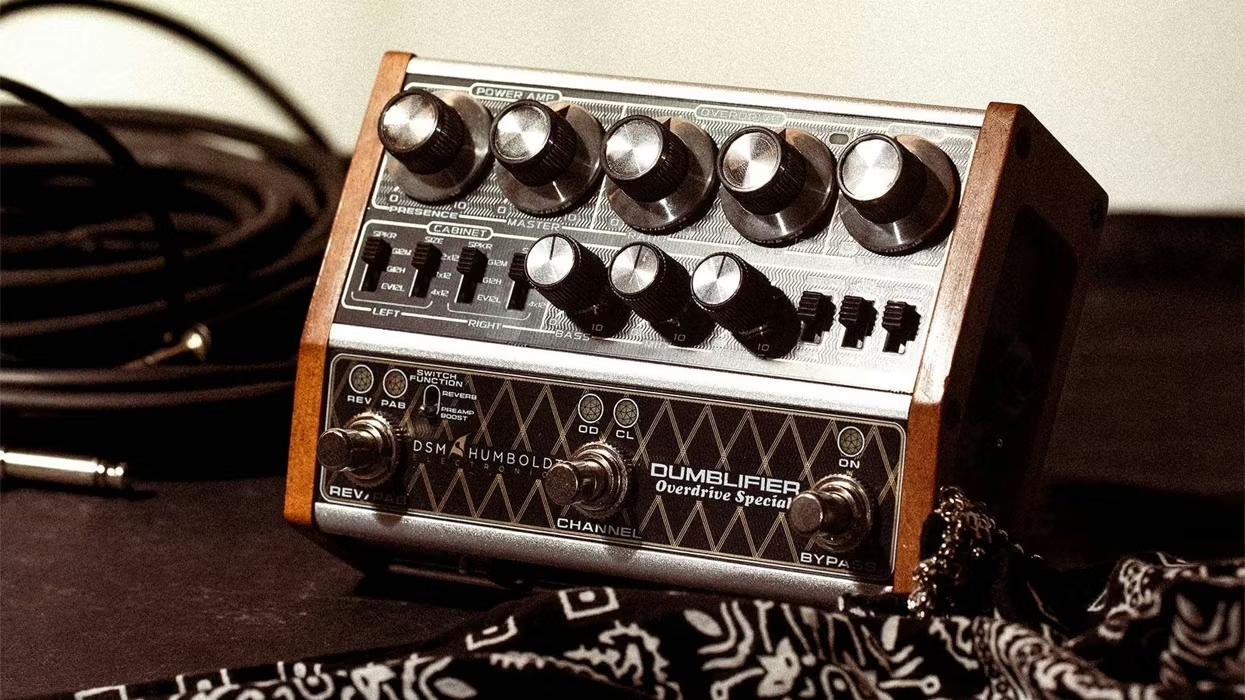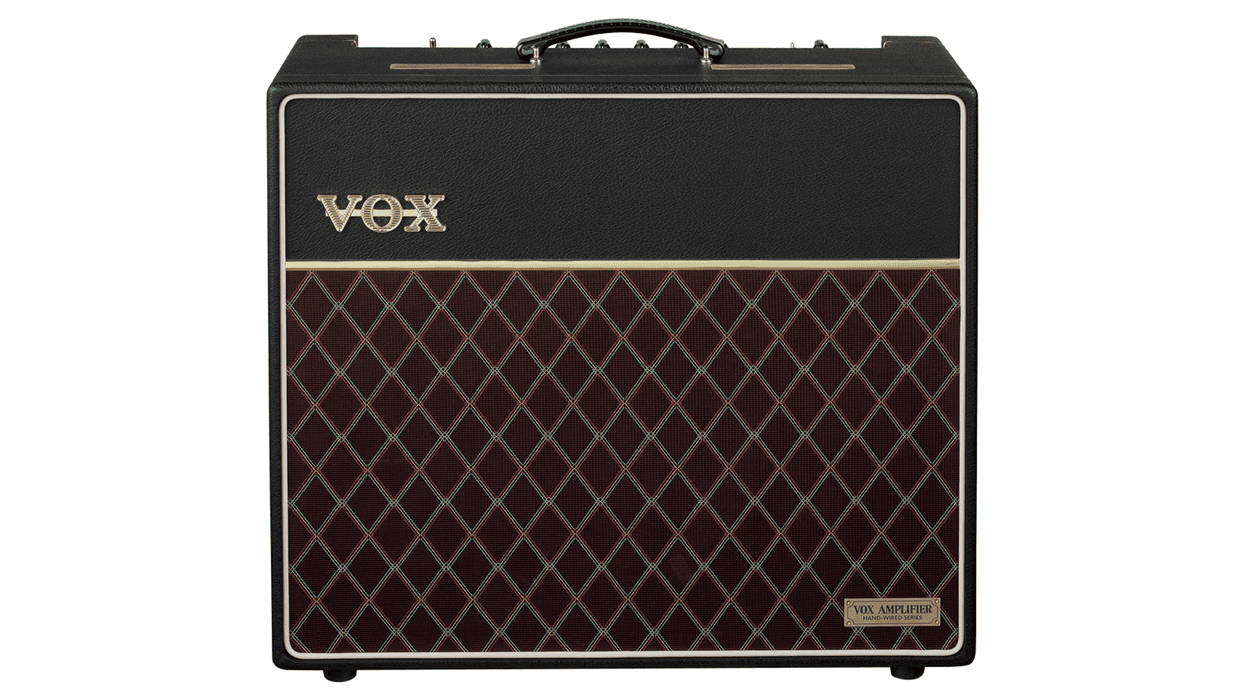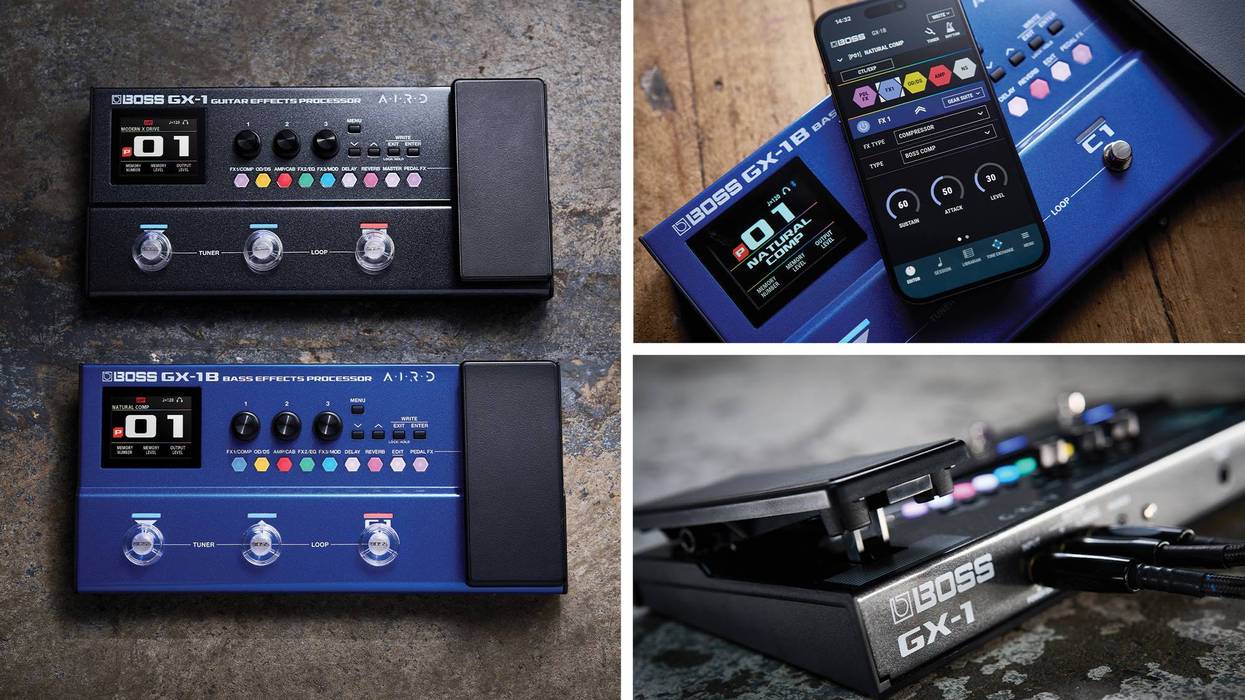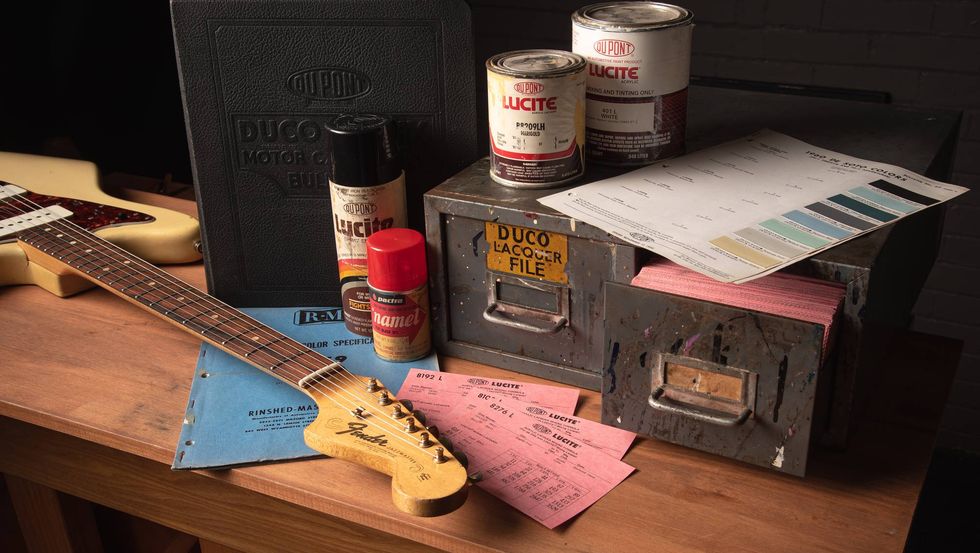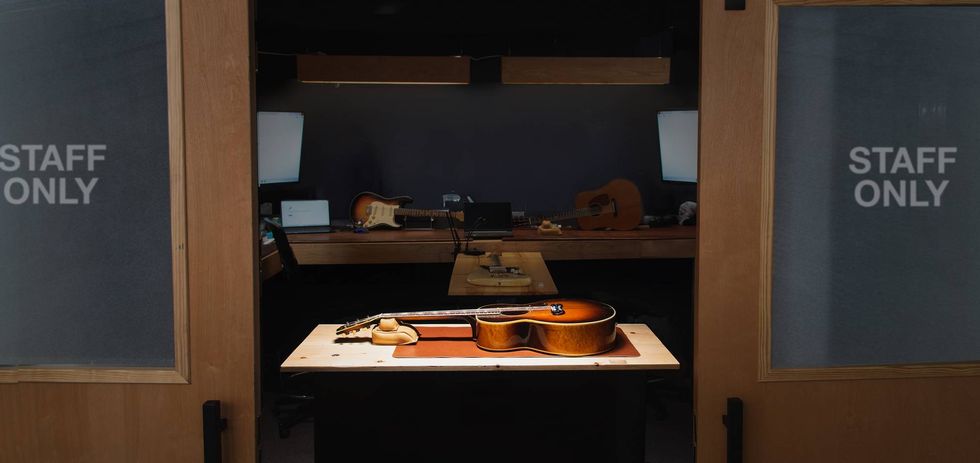Whammy bar technology has evolved significantly from the electric guitar’s golden era to today’s ever-changing design innovations. Because of this, guitarists have been able to warble and divebomb single notes and add some shimmer to chords. There have been many designs throughout history and there are just as many being made today, but the most historically significant ones are the ones we’ll look at here: the Bigsby, Fender, Floyd Rose and Kahler tremolos. Each of these has pushed the evolution of the vibrato-ed note, while being very distinct in design, functionality, performance and practicality. Each has its own characteristics, which dictate how much wham you put in your whammy.
Before we continue, though, it should be pointed out that the wiggle stick has been historically misnamed. The term tremolo is defined as a rhythmic fluctuation of volume, whereas vibrato is a fluctuation in pitch. Technically, the contraptions being discussed here achieve vibrato; but Fender, being the most influential guitar manufacturer on the planet, named their design a tremolo. From the inception of their vibrato bridge, the term tremolo is the most widely accepted name for this particular guitar part.
Vibrato technique by hand has always been an acquired art. It’s an emotive expression of a note or chords executed by the fretting hand. It can be performed subtly or in the extreme. Tremolos give us the mechanical assistance to create vibrato in a completely different way.
One of the earliest examples of a tremolo bridge was made by acoustic harp-guitar luthier Joseph Bohmann at the turn of the twentieth century. Mounted to the bridge of the guitar, it looks like a handle with a ball grip at the tip. It has been argued that this was a hand rest. However, many who have played a Bohmann guitar report that slight downward pressure on this handle causes a flexing of the acoustic top, which creates a vibrato effect on notes and chords. It wasn’t until the late 1940s that the industrial revolution would spur the creation of a steel tremolo that was easier to use.
Hit page 2 for a look at the one that started it all: Bigsby...
It Begins With The Bigsby
The Bigsby Vibrato was the first successful production tremolo. It was conceived in the late 1940s but produced with technology that is representative of the 1950s. The original intent was for downward movement of the tailpiece to cause a slacking of the strings. The Bigsby was designed to be mounted on the top surface of either a hollowbody or solidbody guitar. The strings are anchored and wrapped around a metal bar that is the moveable part of a big hinge. The strings then pass over a rocker bridge that is mounted onto the face of the guitar. The arm rests on a thick gauge return spring, and the pressure of the strings holds the spring in place. When the arm is pressed, the slacking of the strings causes the bridge to move in the strings’ direction, which lowers their tension and thus, their pitch. When the arm is returned to its resting position, the strings should return (ideally) to tuned pitch.
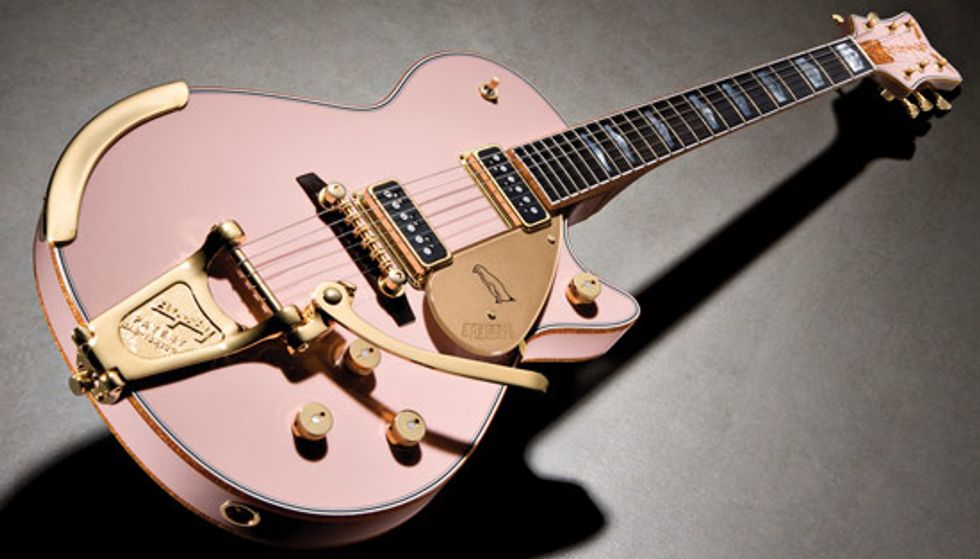 This first Gretsch Custom Shop guitar, a Pink Penguin with Bigsby tremolo, was master-built by Stephen Stern for Boz Boorer, guitarist and musical director for Morissey. Photo courtesy Fender |
This tremolo takes little effort to use, and the arm has a limited range of downward travel. An inability to return to pitch accurately and a thinning of the tone, however, are inherent characteristics on the original Bigsby. A design revision shows a retainer bar preceding the strings’ travel to the bridge, creating a sharper break angle to increase sustain, which was a good thing. The revision also added more pressure on the bridge to couple it to the body more substantially, which increased the resonation factor, but resulted in the problem of friction at the bridge saddles.
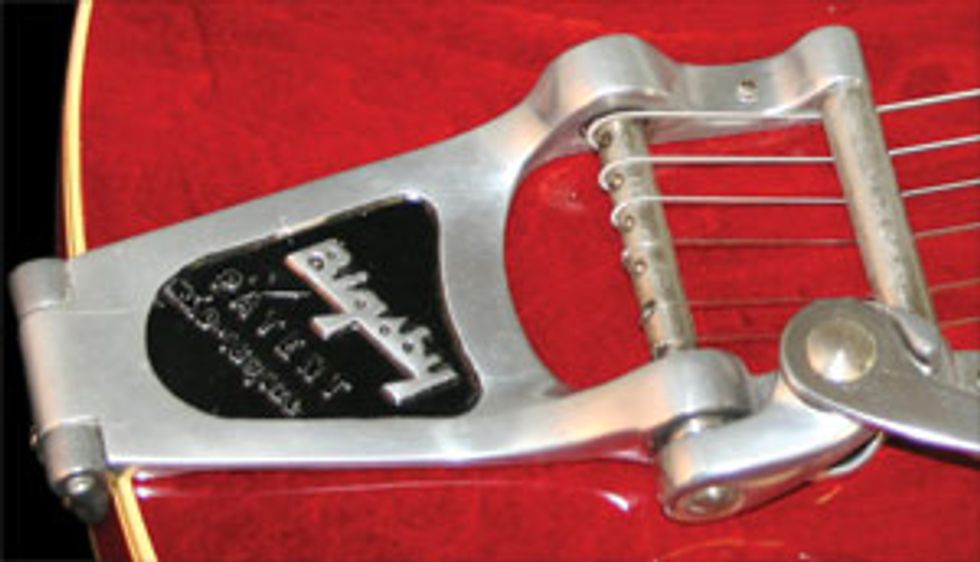 Bigsby with retainer bar Fender Synchronized Tremolo Photo courtesy Dave’s Guitar Shop |
Players with a need for warbling enjoyed the Bigsby for a time, but the limitations created a need for improvements. The Bigsby’s arm was only intended for a downward motion that lightly detuned the pitch of notes and chords. Pulling up on the arm would cause catastrophies, like the return spring falling out.
Hit page 3 for Fender's innovations...
Enter The Fender
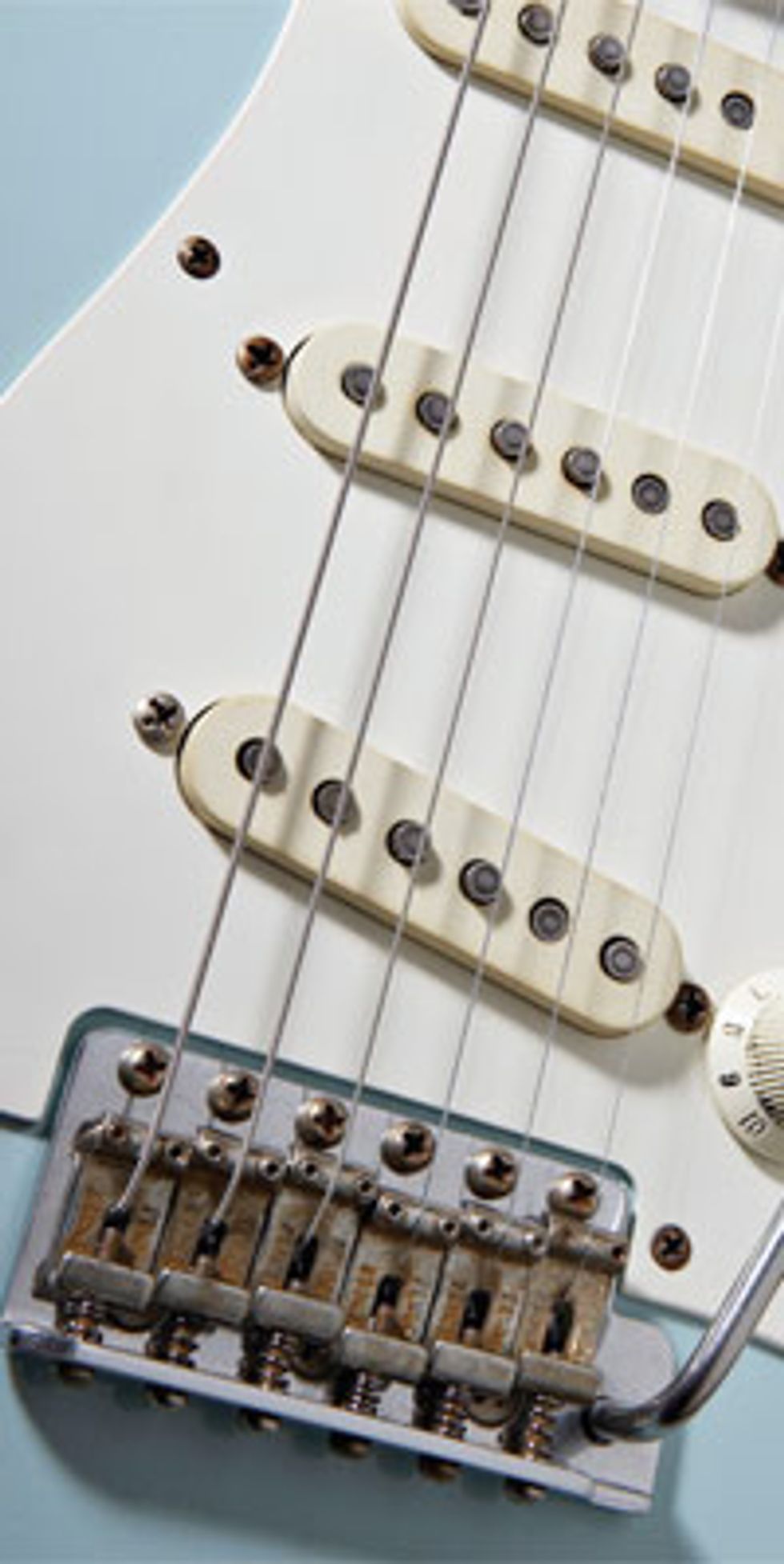 Fender Synchronized Tremolo Photo courtesy Fender |
The Fender tremolo was a feat of engineering. It is attached to the guitar both externally and internally, as a single assembly. This tremolo bridge consolidated the tailpiece and bridge into a single unit that pivots off six screws. The baseplate of the tremolo is mounted to a steel sustain block with a considerable amount of mass. Six bent nickel-plated bridge pieces are anchored to the baseplate and are adjustable to intonate each string more accurately. One outstanding feature in the Fender tremolo bridge is the ability to adjust the height of each string— something that could only be done previously with two screws on the treble and bass sides of a guitar’s bridge. The arm screws into the baseplate and continues into the sustain block, making the assembly move as a whole. With the strings tuned, the bridge is counterbalanced by three to five springs, anchored by a claw inside a cavity routed in the underside of the body. These springs pull the sustain block backward while the strings pull the whole bridge forward. It is a balancing act. This is what makes the Fender so much more responsive to the touch of its tremolo arm. The Fender tremolo was also easier to comprehend, because it was self-contained. The strings are threaded through the sustain block to the saddles. Because the strings are coupled with the steel sustain block and pivot from the six bolts screwed into the wood of the body, there is a more substantial tone compared to the Bigsby. The Fender tremolo also has a further travel, and was designed to have upward as well as downward movement. The tremolo arm has a stiffer feel and is much more responsive to the touch. As cool as that design is, though, there are some inherent problems.
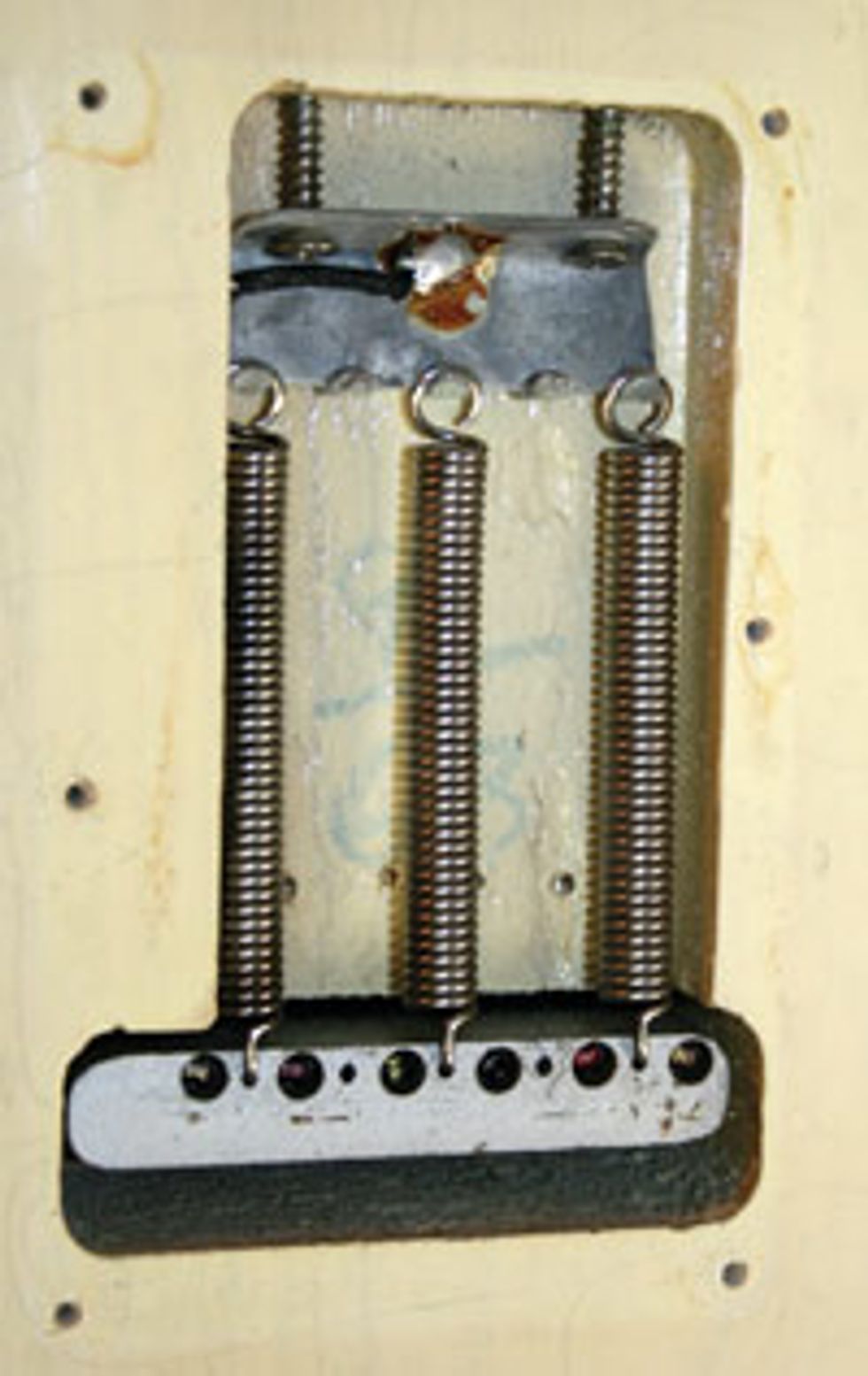 Vintage Fender tremolo cavity Photo courtesy Dave’s Guitar Shop |
Regardless of small shortcomings, this Fender tremolo bridge was resilient to abuse, and if its design was understood, players had no problem maintaining it. To alleviate friction at the nut, many players chose to tighten the springs in the back to anchor the baseplate firmly to the body, giving it only downward motion, and limiting the amount of friction hang up in the nut.
The Fender tremolo bridge (and licensed versions of it) prevailed for most of electric guitar history so far. Fender has since made modern revisions to their tremolo. On some later-produced Stratocaster guitars, the bent steel saddles were replaced by solid block saddle pieces. Along with Bigsby, there were also others made by Mosrite and Gibson. But none rivaled the playability and action of the Fender tremolo. As the electric guitar entered the 1970s, more extreme conditions created a need to build a better mousetrap.
Hit page 4 for the "better mousetrap," courtesy of a man named Floyd...
The Better Mousetrap
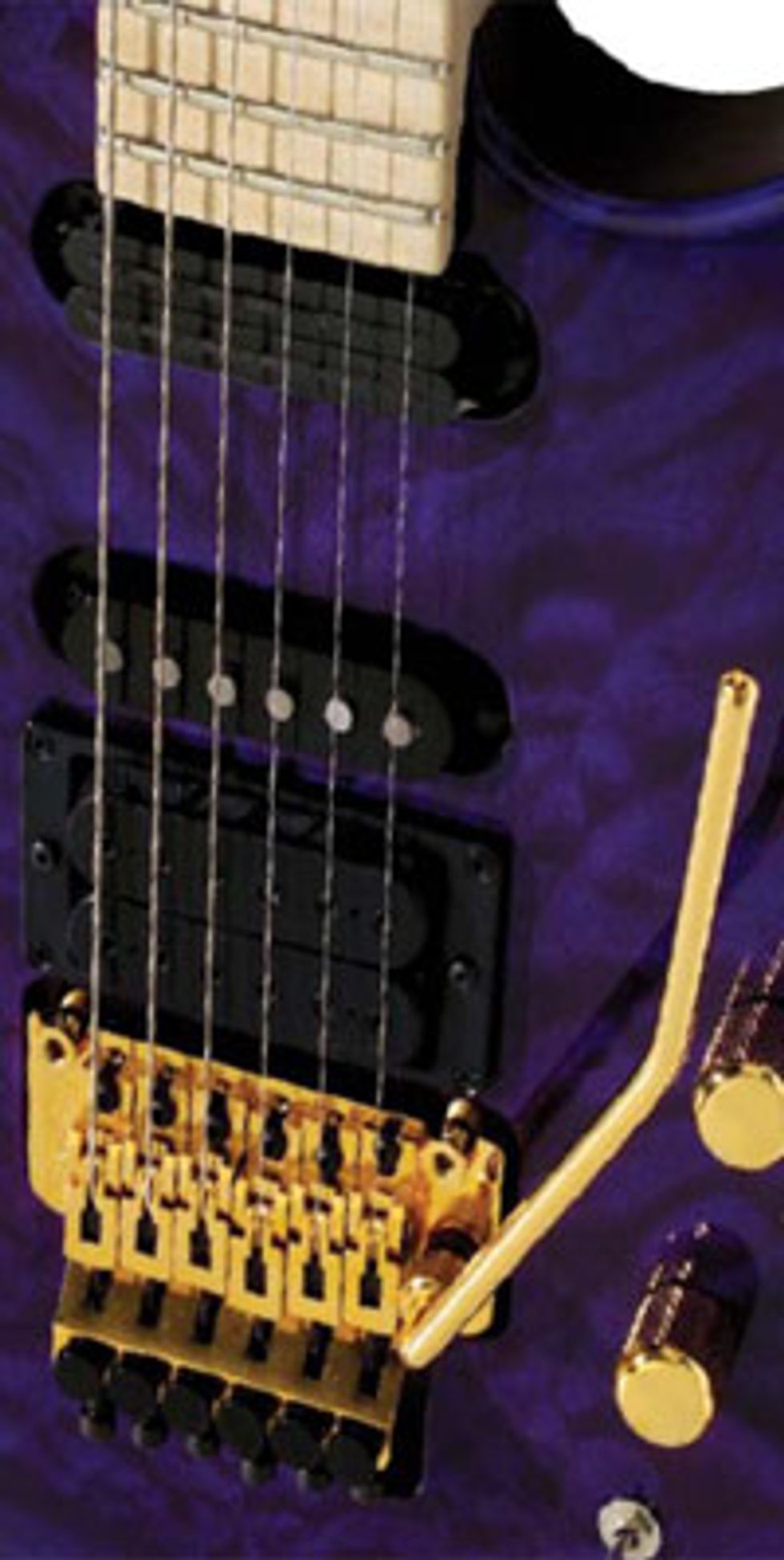 Jackson Phil Collen PC1 with Floyd Rose tremolo Photo courtesy Fender |
The Floyd Rose tremolo system consists of a locking bridge that works in conjunction with a locking nut. The concept is to lock the strings into each individual bridge saddle. Then, once the guitar is tuned, the nut is locked. The strings are clamped at either end and there isn’t anything in between. As simple as that sounds, the assembly of Floyd’s tremolo has almost twice the number of parts as the Fender.
The Floyd Rose, being influenced by the Fender tremolo, uses the same kind of body routing, with minimal changes in the width of the rout for the top of the body. The six individual bridge saddles are mounted to a thick metal baseplate that also allows the saddles to intonate individually. At the rear of each of these saddles is a long, 3mm Allen screw, which tightens a small metal block inside, clipping off the ball end of the string. This block is what holds the string in the saddle. The original Floyd Rose tremolo arm is attached to the bridgeplate through a series of adjustable bushings that can be used to limit the amount of swing in the arm. Or, if you wanted, the arm could simply be tightened to stay in a fixed position. The arm itself was thicker than the Fender, which rendered it unbreakable. The bridgeplate assembly is bolted to a steel block, much like the Fender. When tuned to pitch, the strings are counterbalanced by springs in the rear cavity rout of the body. The whole assembly was originally designed to float above the surface of the body and pivot off two screws (on the bassand treble sides) that couple it with knife edges in the baseplate of the bridge.
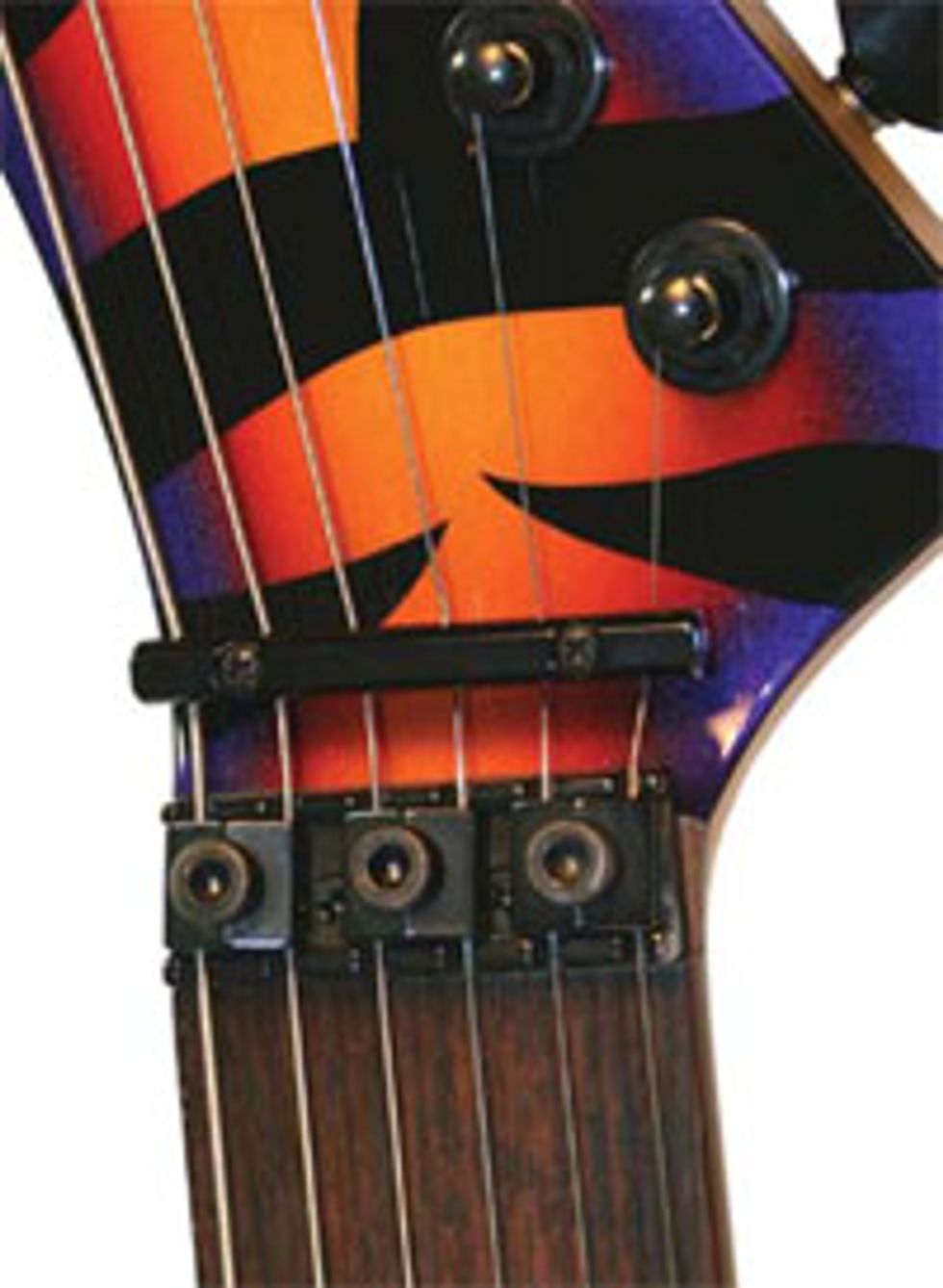 Floyd Rose locking nut with retainer bar Photo courtesy Dave's Guitar Shop |
The beauty of regular maintenance on the Floyd Rose system revolved around a single 3mm Allen wrench. This was the key to changing the strings and locking the nut. If the Floyd Rose is working properly, one 3mm Allen wrench is all you need to do the necessary maintenance—that, and a pair of wire cutters.
Because the strings are locked in both areas, a guitar player can now take guitar playing to extremes, like dive-bombing notes by forcing the bar down all the way to the body. Notes could also be raised a third, fifth, or even the seventh pitch above the picked note. Special effects like chirping, howling and squealing could be achieved by working the bar. Through all this musical abuse, the guitar would stay in tune.
The shortcomings of the Floyd Rose are minimal. Unlike the Fender bridge, the Floyd Rose bridge doesn’t have individual string height adjustments. This adjustment is important to follow the radius of the neck. The six saddles of the Floyd Rose have three compensated heights: the highest two are positioned for the G and the D strings, the middle height for the B and A strings, and the low-height saddles for the high and low E strings. Although this makes a good approximate arc, it is not conducive to accurately adjusting the action to match the radius of the neck. Shimming the individual saddles is the only solution to fine-tuning a radius match with the saddle heights.
In addition, breaking a string in the middle of a song rendered the guitar completely out of whack, because its balance would be off. Unlike the Fender, which could be adjusted to a non-floating position, the Floyd Rose was permanently injured until a break in the evening’s set when the broken string could be properly changed.
Early users of the Floyd Rose either used it successfully or had problems understanding it. As mentioned earlier, the key to making it work was in the locking nut. However, if the strings went sharp due to a maladjusted retainer bar at the nut, guitar players found themselves purposefully tuning strings flat to approximate correct tuning when the nut was locked. By the mid 1980s, a revised version of the Floyd Rose appeared on the market that remains in production today. It now features fine tuners at the bridge. It became easy to tune the strings, lock them at the nut and fine tune each string. One other design refinement was the tremolo arm’s tightening adjustment. It is now a screw-on collar on the arm itself, threaded to the bushing attached to the baseplate.
Hit page 5 for the conclusion, with a look at Kahler and other more recent developments...
The Arms Race Continues
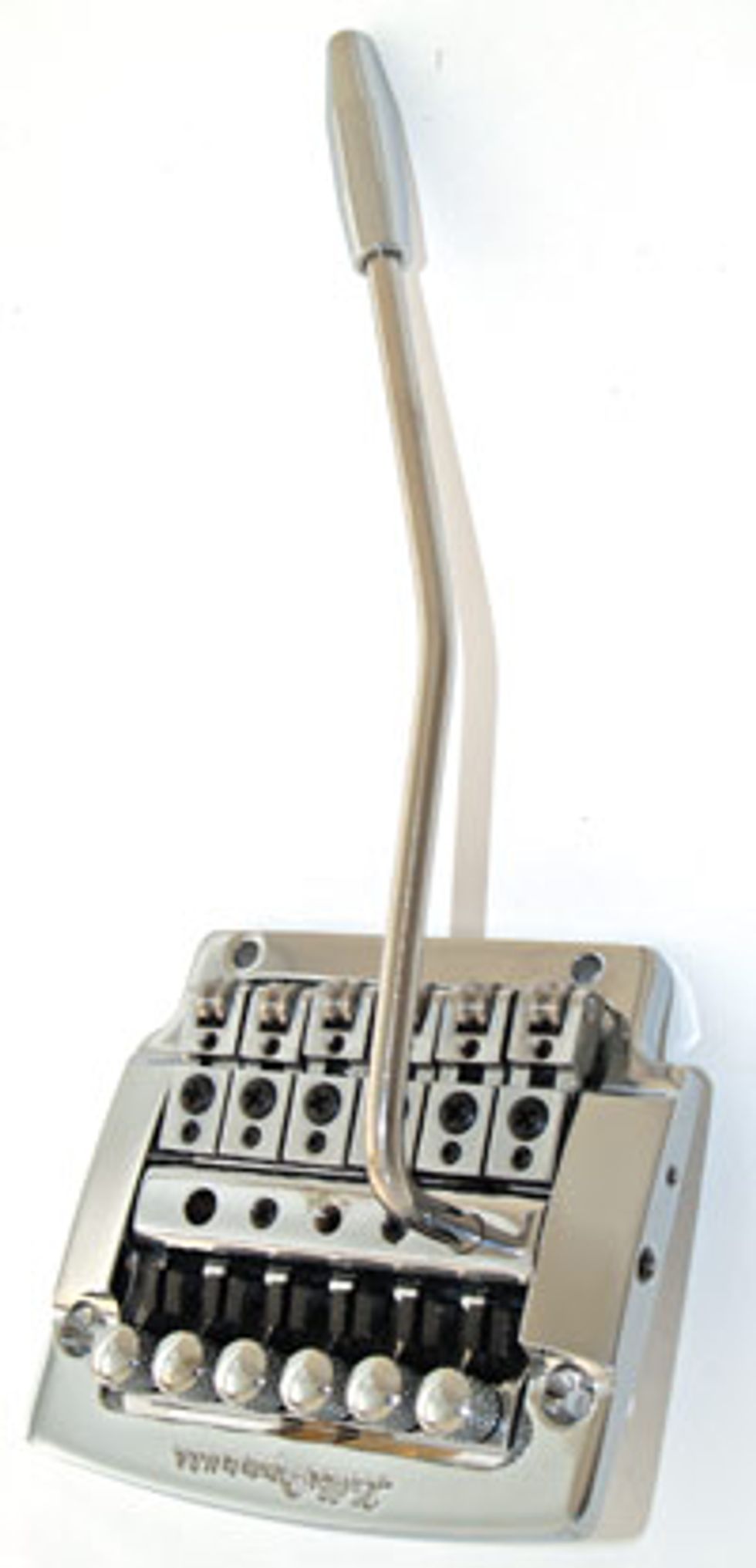 Kahler 2300 tremolo Photo courtesy Kahler International |
Because the cam is the moving mechanism, the arm is screwed into it, giving direct movement from the hand. There is an adjustment hex screw beside the arm that can tighten or loosen the swing action of the arm.
The thing looks like a Sherman tank in comparison to any other tremolo made. It is bolted to the surface of a guitar, and if it is original to the manufacturing of the guitar, it requires less wood routing than a Strat. A simple, small hole is routed to accommodate the return springs. This is a plus for guitar players who want the most mass they can get from a guitar body. For guitars that already have Strat-like routs, the Kahler requires only a small adjustment as a retrofit. Altogether, no matter how a guitar is pre-routed, the Kahler assembly covers it up completely. Kahler also made a version of this tremolo for Gibson-type guitars, stud-mounted to the body. Because it was intended to fit any kind of electric guitar, each individual saddle of the Kahler tremolo could be adjusted in six directions: up or down, for proper string height to follow the radius of the neck; a front-to-back saddle adjustment, to intonate the strings; and a side-to-side adjustment for spacing each string properly.
The Kahler is fully adjustable in other aspects as well. Designed to be a full-floating tremolo, the Kahler features an adjustment to limit just how much upward pull can be achieved. The user could even adjust it for downward travel only. Like the Floyd Rose, the Kahler also has a locking mechanism that clamps the strings. Located at the headstock, this string lock was placed behind an existing traditional nut, locking the strings at the front of the tuning machine posts. Also like the Floyd Rose, there are six fine-tuning knobs at the bridge assembly, located on the cam stop. The fine-tuning feature works much like the Floyd Rose: the strings can be clamped after initial tuning, and small tuning adjustments can be performed after locking the strings.
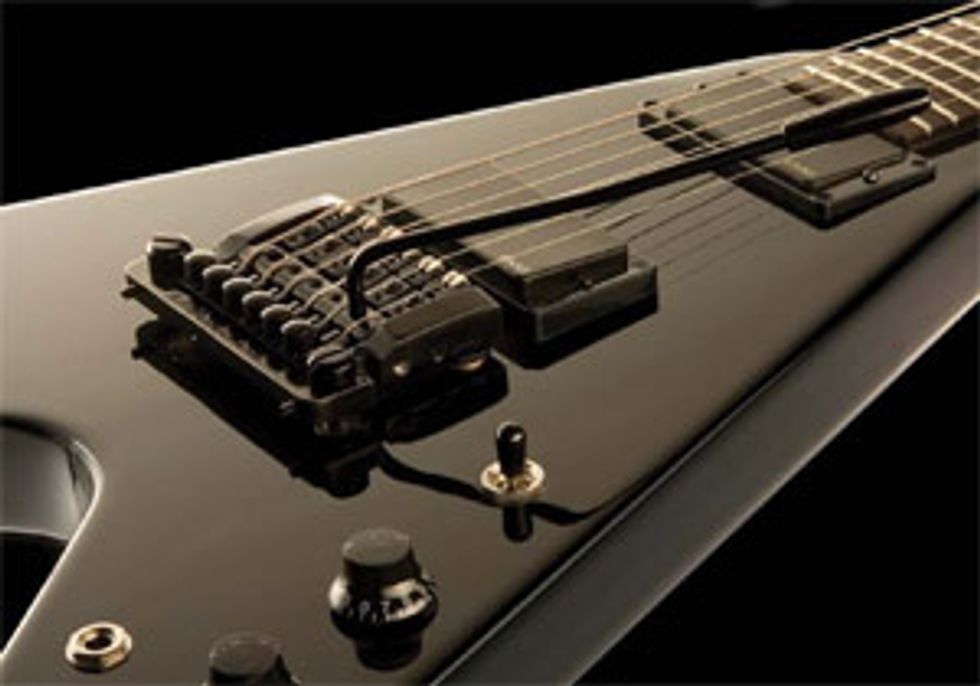 A Kahler 2215K comes standard on Gibson’s Shred V (pictured) and Shred X 2008 Guitars of the Month Photo courtesy Gibson |
Another problematic aspect of the Kahler is the string tension on the cam, which causes the winding on the string balls to unravel. As the strings are tuned, they twist. Since there isn’t any “give” on the blocks holding the ball ends of the string, the winding of the string that holds the ball end comes undone. The ball pops out, and that’s the end of that. Preventative maintenance can be performed by soldering those windings, which is a quick fix only if you have presoldered entire sets of strings beforehand. String manufacturers like Ernie Ball and D’Addario have offered reinforced ball end strings, but when those aren’t available you are left soldering your own strings.
Again, others have come along and entered the game. The Maestro Lyre was an original design tremolo that enjoyed some success with Gibson, adorning the SG and Firebird models. The Wilkinson, the Bowen Handle, the Rockinger and the Wonderbar (to name a few) all had some share in the limelight and many other brands are preferred by different players today. But they are all derivative of the Bigsby, Fender, Floyd Rose and Kahler tremolos that are still in production today. These rival forces remain at the forefront of wang-bar technology.








